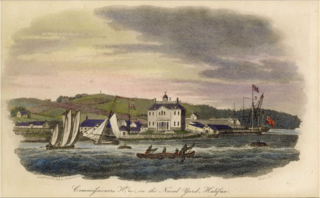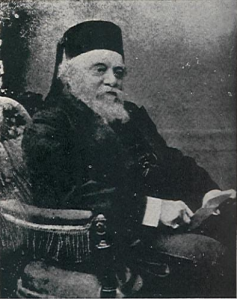
The Navy Board was the commission responsible for the day-to-day civil administration of the Royal Navy between 1546 and 1832. The board was headquartered within the Navy Office.
The Wadia family is a Parsi family from Surat, India, currently based in Mumbai, India. The family rose to wealth in the mid-1700s as shipbuilders serving the British East India Company as the latter established its sway over India.
Lovji Nusserwanjee Wadia (Lowjee Nusserwanjee Wadia) (1702–1774) was a Parsi from Surat province of Gujarat in India and was a member of the Wadia family of shipwrights and naval architects. Lovji was founder of Wadia Group in 1736.

Royal Naval Dockyard, Halifax was a Royal Navy base in Halifax, Nova Scotia. Established in 1759, the Halifax Yard served as the headquarters for the Royal Navy's North American Station for sixty years, starting with the Seven Years' War. The Royal Navy continued to operate the station until it was closed in 1905. The station was sold to Canada in 1907 becoming His Majesty's Canadian Dockyard, a function it still serves today as part of CFB Halifax.

HMS Malabar was a 74-gun third-rate Repulse-class ship of the line of the Royal Navy, built by the Parsi shipbuilder Jamsetjee Bomanjee Wadia and launched on 29 December 1818 on the Upper Duncan Dock at Bombay Dockyard.

Ardaseer Cursetjee Wadia FRS was an Indian Parsi shipbuilder and engineer belonging to the Wadia ship building family.

Naval Dockyard, Mumbai, abbreviated as ND (Mbi) and previously known as the Bombay Dockyard, is an Indian shipbuilding yard in Mumbai.

HMS Cornwallis was a Royal Navy 54-gun fourth rate. Jemsatjee Bomanjee built the Marquis Cornwallis of teak for the Honourable East India Company (EIC) between 1800 and 1801. In March 1805 Admiral Sir Edward Pellew purchased her from the Company shortly after she returned from a voyage to Britain. She served in the Far East, sailing to Australia and the Pacific Coast of South America before returning to India. In February 1811 the Admiralty renamed her HMS Akbar. She captured forts and vessels in the Celebes and Amboyna, and participated in the invasion of Isle de France, and the 1811 invasion of Java. She also served in the West Indies before being laid up at Portsmouth in December 1816. She then stayed in Britain in a number of stationary medical and training capacities until the Admiralty sold her in the 1860s.
HMS Howe was originally the teak-built Indian mercantile vessel Kaikusroo that Admiral Edward Pellew bought in 1805 to serve as a 40-gun frigate. In 1806 the Admiralty fitted her out as a 24-gun storeship and renamed her HMS Dromedary. She made numerous trips, including one notable one to Australia when she brought out Lachlan Macquarie and his family to replace William Bligh as governor of New South Wales. Later, she became a prison hulk in Bermuda. Her most recent contribution, however, is as the source of a rich archaeological site.

The Navy Office was the government office responsible for the civil administration of the British Royal Navy from 1576 to 1832. It contained all the members of the Navy Board and various other departments and offices. The day-to-day business of the Navy Office was headed by the Clerk of the Acts from 1660 until 1796. When this position was abolished duties were assumed by separate committees for Accounts, Correspondence, Stores, Transports and Victualling presided over by the Comptroller of the Navy. The Navy Office was one of two government offices that were jointly responsible for directing naval affairs. In 1832 following reforms of the naval service the Navy Office was abolished and its functions and staff taken over by the Admiralty.
Jamaica Dockyard also known as Port Royal Dockyard was a British Royal Navy Dockyard located at Port Royal, Jamaica. It was established 1675 and closed in 1905. The dockyard was initially administered by the Navy Board then later the Board of Admiralty.
Kinsale Dockyard was a British Royal Navy base located at Kinsale, Ireland from c. 1647 to 1812.
Shah Ardaseer was built at Bombay, probably in 1786. English transliterations of her name show her as Shah or Shaw + Adaseer, or Ardaseer, or Ardasier, or Adasier, or Ardasheer, or Ardeseer, or Ardesir. A fire on 13 September 1809 at Bombay burnt her. She then may have been recovered, repaired, and enlarged to become the hulk HMS Arrogant, which was moved to Trincomalee in 1822 and sold there in 1842.
Ardaseer was an opium clipper built at Bombay Dockyard in 1836. A fire on 4 April 1851, destroyed her as she was on a voyage from China to Calcutta via Singapore.
HCS Vestal was built in 1809 at the Bombay Dockyard for the Bombay Marine, the naval arm of the British East India Company (EIC). She spent much of her career suppressing commerce raiding in the Persian Gulf. Lastly, she figured in a notable action during the First Anglo-Burmese War. She was subsequently condemned as unserviceable and sold for breaking up.

Asia was built at Bombay Dockyard in 1797. She made at least two voyages for the British East India Company (EIC) before the British Royal Navy purchased her in 1805 in the East Indies. The Royal Navy renamed her HMS Sir Francis Drake and used her as a frigate. She served in the Java campaign of 1811. When she returned to England in 1813 she was refitted as a storeship. Later, she became the flagship, at Newfoundland, for the governors of Newfoundland. The Admiralty sold her in 1825. New owners renamed her Asia and she sailed between Britain and London until 1831 when Portuguese interests purchased her. She then became the frigate Dona Maria II for the Liberal forces that were attempting to install the rightful queen, Dona Maria II, to the throne of Portugal, and overthrow Dom Miguel, who had usurped the throne. In early 1849 conflict developed between the Portuguese government in Macau and the Chinese government over who could collect taxes and tariffs at Macao. Dona Maria II sailed to Macao as part of a small squadron. An internal explosion destroyed her in the harbour on 29 October.

Jamsetjee Bomanjee Wadia was an Indian shipbuilder and member of the Wadia family.
William was launched at the Bombay Dockyard in 1800 as a country ship, i.e., a vessel trading east of the Cape of Good Hope. In 1801 she served as a transport in a naval campaign. In 1809 she made a voyage to London for the British East India Company (EIC). She survived several maritime incidents while sailing as a West Indiaman. She was last listed in 1826.
John Tasker (1742–1800) was a Welsh sea captain and shipowner who became the East India Company's Master Attendant at Bombay and purchased the Upton Castle estate in his native Pembrokeshire where he was High Sheriff in 1798.









